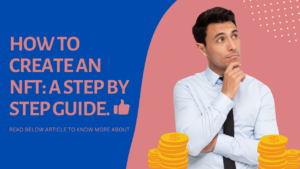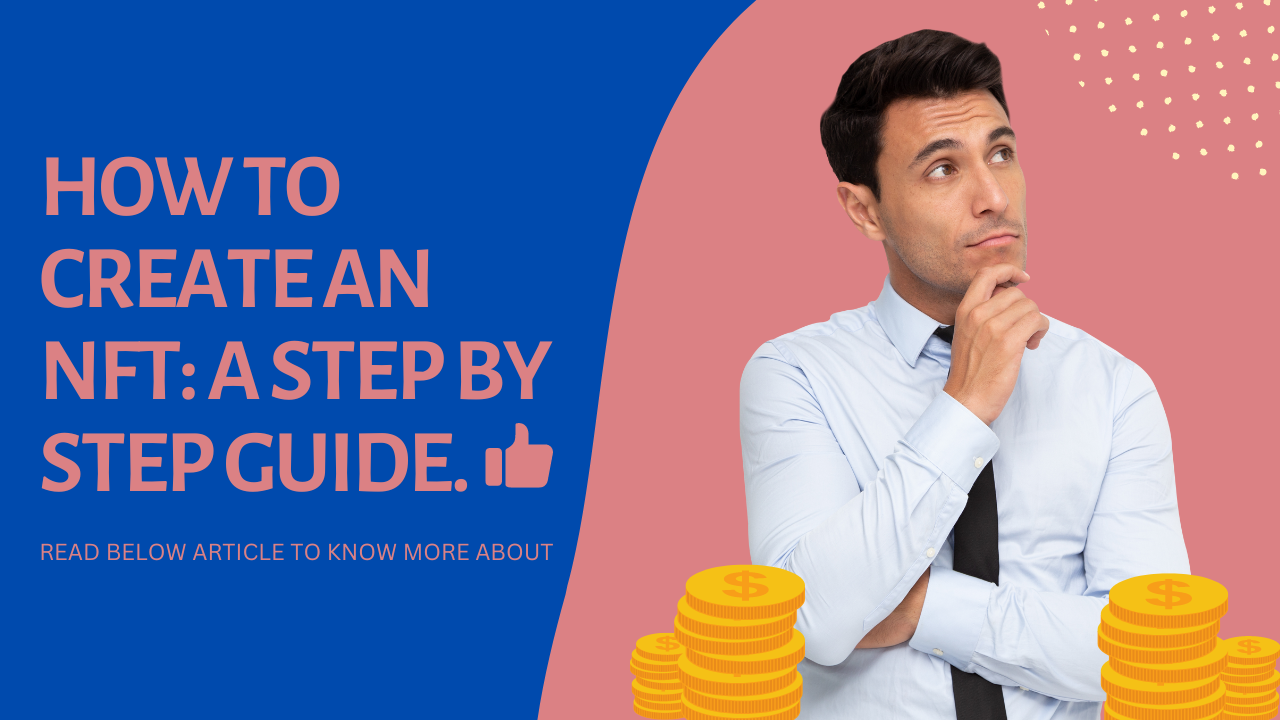NFTs are the newest buzzword in the realm of digital collectibles and art. They have revolutionized the art market by allowing artists to sell their works for millions of dollars thanks to their capacity to validate ownership and the rarity of digital assets. But how can you produce your own NFT and join the privileged group of digital artists? This step-by-step tutorial will walk you through every stage of creating your own NFT, from selecting a platform to minting and selling your invention. So put on your thinking cap and let’s get started.

Overview of NFTs and its rising popularity
Non-fungible tokens, or NFTs, are revolutionizing the art world and beyond. These unique digital assets, built on blockchain technology, provide a way for creators to authenticate and monetize their work in a way that was never before possible. With NFTs, artists and collectors alike are able to benefit from the transparency and security of blockchain, as well as the unique value of one-of-a-kind pieces.
The popularity of NFTs has exploded in recent years, with high-profile sales like Beeple’s “Everyday: The First 5000 Days” fetching millions of dollars. But NFTs are not just for the elite; they offer a new way for artists of all levels to showcase their work and connect with collectors.
As NFTs continue to gain traction, we can expect to see even more innovative uses of this technology in the future. From music to sports memorabilia, the possibilities for NFTs are endless, making them a fascinating development in the world of digital assets.
Importance of Knowing How to Create an NFT:
- Knowing how to create an NFT is becoming increasingly important, especially for artists, musicians, and other creators who want to monetize their digital assets. By creating an NFT, creators can ensure that they retain ownership of their digital assets and can sell them securely and transparently to collectors.
- Creating an NFT can also provide a new revenue stream for creators, allowing them to earn money from their digital assets and reach a wider audience. By creating an NFT, creators can also ensure that their digital assets are properly authenticated and that their ownership is verified.
Step-by-Step Guide on Creating an NFT
- Step 1: Choosing a Blockchain Platform
There are several blockchain platforms available to create NFTs, including Ethereum, Binance Smart Chain, Flow, and more. Each blockchain has its own set of rules, fees, and limitations. So, it is essential to choose the right platform that aligns with your goals and requirements.
- Step 2: Creating a Wallet
A wallet is necessary to store and manage your NFTs. Each blockchain has its own wallet, and you need to create a wallet to interact with the blockchain. You can use popular wallets like MetaMask, MyEtherWallet, and Trust Wallet, among others, to manage your NFTs.
- Step 3: Creating Digital Artwork
The core of the NFT is digital artwork or media. You can create artwork in various formats such as images, videos, music, or other digital assets. Ensure that the artwork is unique and represents your creativity.
- Step 4: Uploading the Artwork to the NFT Platform
After creating the artwork, you need to upload it to the NFT platform of your choice. Each marketplace has its own uploading process, but generally, you need to create an account, connect your wallet, and upload the artwork.
- Step 5: Minting the NFT
Minting an NFT means creating a unique digital token on the blockchain. When you mint an NFT, you create a smart contract on the blockchain, which verifies the ownership and authenticity of the digital asset. To mint an NFT, you need to provide details such as title, description, and other metadata, along with the digital asset.
- Step 6: Setting a Price for the NFT
After minting the NFT, you can set a price for it. The price can be in the cryptocurrency of the blockchain platform you choose. You can also choose to set the NFT’s price in fiat currency, but it depends on the NFT marketplace.
- Step 7: Launching the NFT
Once you’ve set a price, you can launch your NFT on the marketplace. The NFT will be visible to other users, and they can purchase it if they want. You can promote your NFT on social media, blogs, or other platforms to increase its visibility.
In conclusion, creating an NFT involves choosing the right blockchain platform, creating digital artwork, uploading it to the NFT marketplace, minting it, setting a price, and launching it. With the right approach and promotion, you can monetize your creativity through NFTs.
Marketing and Selling NFTs
Marketing and selling NFTs (non-fungible tokens) require a targeted approach to reach the right audience and communicate the unique value of your digital assets. Here are some strategies for marketing and promoting NFTs, where to sell them, and best practices for selling NFTs:
Strategies for Marketing and Promoting NFTs:
- Use social media: Social media platforms are a powerful tool to promote NFTs. Share your NFT artwork on platforms like Twitter, Instagram, TikTok, and Discord to reach a wider audience.
- Collaborate with Influencers: Collaborating with influencers in your niche can help you reach a wider audience. They can promote your NFTs to their followers and provide testimonials about your work.
- Create a website: Creating a website for your NFTs is a great way to showcase your work and provide more information to potential buyers. You can also use the website to offer exclusive discounts and bonuses.
- Participate in Online Communities: Participating in online communities that share your interests can help you connect with potential buyers. Join NFT-specific groups on Reddit, Discord, and Telegram to share your work and network with like-minded individuals.
Where to Sell NFTs
- NFT Marketplaces: NFT marketplaces like OpenSea, SuperRare, and Nifty Gateway allow you to list and sell your NFTs. These platforms have a large user base and are trusted by buyers and sellers.
- Social Media: Social media platforms like Twitter and Instagram allow you to sell your NFTs directly to your followers. You can use a variety of payment methods, including cryptocurrency and PayPal.
Best Practices for Selling NFTs
- Set a Realistic Price: Setting the right price for your NFTs is crucial. Do some research on similar NFTs and consider factors like the time and effort you put into creating the artwork.
- Offer Exclusive Bonuses: Offering exclusive bonuses like access to a private Discord channel or a personalized message from the artist can incentivize buyers to purchase your NFTs.
- Provide Detailed Information: Providing detailed information about your NFTs can help buyers make informed decisions. Include details like the artwork’s dimensions, file type, and edition number.
- Engage with Potential Buyers: Engaging with potential buyers can help build trust and encourage them to make a purchase. Respond to their questions and offer them personalized attention to make the buying process smooth and enjoyable.
In summary, marketing and selling NFTs require a targeted approach that focuses on reaching the right audience and communicating the unique value of your digital assets. By following these strategies and best practices, you can increase your chances of success and generate more sales.
FAQs
What kind of digital assets can be turned into NFTs?
Any digital asset that is unique and can be owned, such as artwork, music, videos, tweets, virtual real estate, and more.
Do I need to be a programmer to create an NFT?
No, you do not need to be a programmer to create an NFT. There are several user-friendly platforms and tools available that allow you to create and mint NFTs without any coding knowledge.
What are the benefits of creating an NFT?
Creating an NFT can help you monetize your unique digital content, establish your brand as an artist or creator, and gain exposure in the growing NFT market.
Can I sell my NFT on multiple marketplaces?
Yes, you can sell your NFT on multiple marketplaces, but you need to make sure that you do not sell the same NFT twice. You can use a blockchain explorer to track the ownership of your NFT.
How do I set the price of my NFT?
The price of your NFT depends on various factors, such as the rarity and demand of your digital asset. You can research the prices of similar NFTs on different marketplaces and set your price accordingly.
What are the legal implications of creating an NFT?
Creating an NFT involves complex legal issues, such as copyright, intellectual property rights, and ownership. You should consult a legal expert before creating and selling an NFT.
Can I buy an NFT with cryptocurrency?
Yes, most NFT marketplaces accept cryptocurrency as payment, such as Bitcoin, Ethereum, and other popular cryptocurrencies. You need to have a cryptocurrency wallet to buy and sell NFTs.
Also read:
How to Use NFT Marketplaces for Buying and Selling?
How to Price Your NFTs: A Comprehensive Guide
How to sell NFT: Tips and Strategies
Conclusion
Unique digital assets known as NFTs have grown in popularity recently. They provide both makers and collectors with fresh opportunities to profit from their digital creations. It is becoming more and more crucial to understand how to construct an NFT, especially for artists who wish to benefit from this new technology and commercialize their digital goods safely and openly.

Neelam is a talented writer and financial analyst, currently studying at Hansraj College. She is a regular contributor to Trickyfinance, where she covers a range of topics including price prediction, stock market news, and market analysis. Neelam’s passion for finance and economics led her to pursue a writing career in the financial industry, where she has gained valuable experience and insights into the workings of the market. In her free time, Neelam enjoys reading and conducting her own market analysis to stay up-to-date with the latest trends and developments in the industry.




